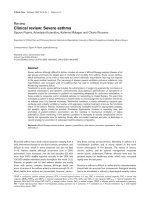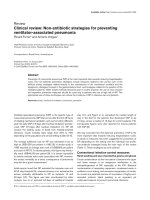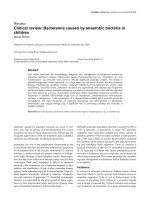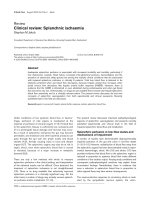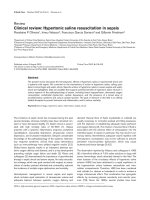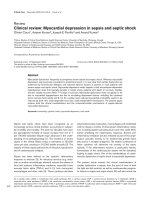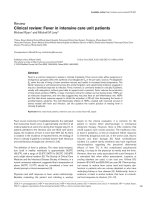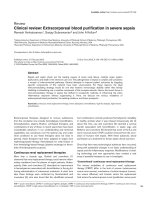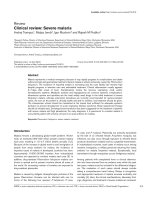Báo cáo y học: "Clinical review: Hypertonic saline resuscitation in sepsis" potx
Bạn đang xem bản rút gọn của tài liệu. Xem và tải ngay bản đầy đủ của tài liệu tại đây (54.74 KB, 6 trang )
HOG = high-osmolarity glycerol response; HSS = hypertonic saline solution; MAPK = mitogen-activated protein kinase.
Critical Care October 2002 Vol 6 No 5 Oliveira et al.
The incidence of septic shock has increased during the past
several decades, whereas mortality rates have remained con-
stant or have decreased slightly [1]. Septic shock is associ-
ated with high mortality rates of 30–80% [1]. Sepsis
presents with a systemic inflammatory response, peripheral
vasodilatation, myocardial depression, intravascular volume
depression, and increased metabolism. Despite considerable
knowledge of the pathophysiology of the systemic inflamma-
tory response syndrome, clinical trials using interventions
such as immunotherapy have yielded negative results [2,3].
Global tissue hypoxia results in an imbalance between sys-
temic oxygen delivery and demand, and is a key development
preceding multiple organ failure and death [2]. Rivers and
colleagues [2] demonstrated the importance of goal-directed
therapy in septic shock and severe sepsis. An early resuscita-
tion strategy, which was goal oriented with respect to manip-
ulation of cardiac preload, afterload and contractility, reduced
the incidence of multiple organ dysfunction and mortality.
Hemodynamic management in severe sepsis and septic
shock includes rapid restoration of intravascular volume and
adequate balance between systemic oxygen delivery and
demand. Several liters of fluids (crystalloids or colloids) are
usually necessary to normalize preload and filling pressures,
with the objective of establishing adequate tissue perfusion
and oxygen delivery [2]. The infusion of several liters of fluid is
associated with the adverse effect of extravasation into the
interstitial space. In sepsis in particular, this may result in pul-
monary edema. Nevertheless, adequate volume repletion with
hemodynamic normalization may not be sufficient to prevent
persistent microcirculatory dysfunction, which may cause
ischemia and tissue damage [2,4,5].
The observation reported by Velasco and colleagues in 1980
[6] of beneficial effects of 7.5% saline solutions in dogs with
severe hemorrhagic shock attracted interest to this field. The
short duration of the circulatory effects of hypertonic saline
solution (HSS) has been attributed to a rapid equilibrium of
the hyperosmotic solute between extracellular and intra-
cellular compartments. Therefore, HSS has been combined
with colloids (i.e. dextran or hetastarch) in order to achieve a
longer intravascular effect. This combination has synergistic
effects, by increasing plasma osmolarity and osmotic pres-
sure [7,8]. Since the 1980s, several studies have been
Review
Clinical review: Hypertonic saline resuscitation in sepsis
Roselaine P Oliveira
1
, Irineu Velasco
2
, Francisco Garcia Soriano
3
and Gilberto Friedman
4
1
Department of Critical Care Medicine, Santa Casa Hospital, Federal University of Rio Grande do Sul, Porto Alegra, Brazil
2
Chairman of Emergency and Critical Care Department, Department of Internal Medicine – Intensive Care Division, University of São Paulo, São Paulo, Brazil
3
Assistant Professor, Department of Internal Medicine – Intensive Care Division, University of São Paulo, São Paulo, Brazil
4
Professor of Critical Care and Emergency Medicine, Department of Critical Care Medicine, Santa Casa Hospital, Federal University of Rio Grande do
Sul, Porto Alegra, Brazil
Correspondence: Gilberto Friedman,
Published online: 6 August 2002 Critical Care 2002, 6:418-423
This article is online at />© 2002 BioMed Central Ltd (Print ISSN 1364-8535; Online ISSN 1466-609X)
Abstract
The present review discusses the hemodynamic effects of hypertonic saline in experimental shock and
in patients with sepsis. We comment on the mechanisms of action of hypertonic saline, calling upon
data in hemorrhagic and septic shock. Specific actions of hypertonic saline in severe sepsis and septic
shock are highlighted. Data are available that support potential benefits of hypertonic saline infusion in
various aspects of the pathophysiology of sepsis, including tissue hypoperfusion, decreased oxygen
consumption, endothelial dysfunction, cardiac depression, and the presence of a broad array of
proinflammatory cytokines and various oxidant species. The goal of research in this field is to identify
reliable therapies to prevent ischemia and inflammation, and to reduce mortality.
Keywords hemorrhagic, hypertonic saline, inflammation, sepsis, shock
Available online />performed that used small volume resuscitation [6,9–13],
which is defined as a rapid infusion of HSS (NaCl 7.2–7.5%),
in combination with dextran or hetastarch, at a dose of 4
ml/kg into a peripheral vein [6,9–13]. Recent studies have
used HSS in the treatment of sepsis [14–19] and have
demonstrated some promising beneficial effects.
Hypertonic resuscitation in experimental
models of sepsis
There is a decreased susceptibility to sepsis following admin-
istration of HSS in hemorrhagic shock. After 24 hours of
cecal ligation and perforation, animals that received HSS had
fewer bacteria in serum, lower formation of abscesses in liver
and lungs, and less pulmonary and hepatic injury [20].
Reduced organ injury in the HSS group might have been
related to an improved hemodynamic profile and decreased
extrapulmonary volume. Also, effects on microcirculation (i.e.
reduction in ischemia and effects related to immune function)
might have contributed partly to decreased organ injury.
Experimental studies in septic shock have shown beneficial
effects similar to those reported in studies of hemorrhagic
shock [14–19]. Studies of HSS alone or combined with het-
astarch in sepsis demonstrated hemodynamic improvements,
but these effects had a short period of action. However,
these findings bring new possibilities to treatment of septic
patients, if the treatments are instituted early in course of the
disease. Hemodynamic resuscitation per se can reduce the
inflammatory response in sepsis, reducing the phenomenon
of ischemia/reperfusion [2]. On the other hand, several
studies have demonstrated that HSS modulates immune
function favorably (i.e. by reducing production and release of
proinflammatory cytokines and augmenting interleukin-10
induction; by reducing L-selectin expression in neutrophils;
and by reducing the oxidative burst) [21–29]. Together, those
studies indicate that HSS has actions in two important
aspects of septic shock: hemodynamics and immunomodula-
tion. Notwithstanding the recent intense focus on immuno-
modulation in sepsis, Rivers and colleagues [2] showed that
early hemodynamically centered therapy yielded significant
benefits with respect to outcome.
Observations from several experimental studies suggest that
HSS combined with a colloid solution is able to improve
macrocirculation in sepsis [14,18,19,30,31]. Also, HSS pre-
vented vascular dysfunction and restored microcirculatory
blood flow by capillary reopening. This effect resulted in a
beneficial redistribution of regional blood flow to heart,
kidney, and splanchnic organs.
Hypertonic resuscitation in clinical studies of
sepsis
The first clinical study to evaluate the effects of small volume
resuscitation in severe sepsis was conducted by Hannemann
and colleagues [16]. Those authors observed increased
oxygen transport, cardiac output, and pulmonary capillary
wedge pressure in patients treated with HSS. Except for the
increase in pulmonary capillary wedge pressure, none of the
cardiovascular changes lasted for longer than 60 min. Plasma
sodium levels increased and normalized within 24 hours after
HSS infusion.
Oliveira and colleagues [32] studied the hemodynamic
effects of a hypertonic saline/dextran solution as compared
with those of a normal saline solution in severe sepsis.
Patients were randomly assigned, in a blinded manner, to
receive 250 ml of a solution of either normal saline (n = 16) or
hypertonic saline (NaCl 7.5%/dextran 8%; n = 13). Before
they received normal saline or HSS, patients had to have
been stable (i.e. no requirement for vasoactive drug or volume
change) for at least 60 min. Over the 180 min following infu-
sion of normal saline or HSS (i.e. the period of study), the rate
of infusion of regular fluid or vasoactive drug was not
changed. The cardiac and stroke volume indices increased,
and systemic vascular resistance decreased only in the HSS
group, without any change in arterial pressure. The increase
in plasma sodium levels lasted for 6 hours in the HSS group.
Those investigators concluded that hypertonic saline/dextran
solution improved cardiovascular performance and resusci-
tated severely septic patients through a volume effect, but
may also directly improve cardiac function.
Mechanisms of action of hypertonic saline
solution
The main proposed mechanisms of action of HSS are as
follows [14,27,33–49]: instantaneous mobilization of fluids
from intracellular to extracellular compartments by the
osmotic gradient produced by HSS; increased myocardial
contractility; reduced endothelial and tissue edema, improv-
ing microcirculation; improved blood viscosity due to hemodi-
lution; and immunomodulation.
Intravascular volume expansion
A rapid increase in mean arterial pressure occurs following
HSS infusion. Studies have shown a redistribution of fluids
from the perivascular to the intravascular space, and conse-
quent plasma expansion [6,9,50]. The hemodynamic effects
of HSS infusion have been studied in sepsis [15–17,19].
Most of the studies found that HSS infusion caused a rapid
and significant increase in oxygen delivery, and elevated
cardiac output and increased oxygen extraction, but these
effects were transient [15,16,18,19]. Therefore, despite the
immunologic background of sepsis and the significant role
played by immunologic mechanisms in the disease, hemody-
namic resuscitation has also proved important in manage-
ment of sepsis [2]. HSS may be able to resuscitate septic
patients better and more rapidly, during the critical ‘golden
hours’ of the disease.
Cardiac contractility effects
Improvement in myocardial contractility may be related to a
direct hyperosmolar effect, restoring transmembrane poten-
Critical Care October 2002 Vol 6 No 5 Oliveira et al.
tials or decreasing myocardial edema [13,33]. Reported find-
ings indicate that ventricular contractile force is enhanced by
moderate degrees of hyperosmolarity and is depressed by
severe hyperosmolarity both in vivo and in vitro [51]. HSS
has been shown to increase left ventricular dP/dt
max
, cardiac
output, and stroke work at equivalent or lower atrial filling
pressures than with isotonic solutions [10,43,52]. Myocardial
function is depressed even in the early hyperdynamic phase
of sepsis [53]. However, hypertonic solutions have been
shown to improve contractility in animal and human studies of
sepsis [14,54]. These improvements in myocardial perfor-
mance were unrelated to changes in coronary flow or
myocardial oxygen consumption [14].
Neural effect: the role of lung innervation
Two forms of experimental evidence indicate that a pulmonary
reflex mechanism may participate in the resuscitative effects
of hypertonic saline.
First, it has been suggested that passage of hypertonic saline
through the pulmonary circulation is necessary for resuscita-
tion. In dogs, prepulmonary (right atrial, pulmonary arterial)
administration resulted in resuscitation, but postpulmonary (left
atrial, aortic) administration did not provide effective resuscita-
tion [55,56]. However, data from sheep [57] suggested that
the site of administration has no influence on the resuscitative
effects of hypertonic saline. The differences between the
reports may be explained by the different species investigated.
The second form of evidence for lung innervation is provided
by studies indicating that vagal blockade attenuates the
hemodynamic response to hypertonic saline administration in
hypovolemic dogs [50,55,58]. In contrast to this finding,
nearly identical improvements in mean arterial pressure,
cardiac output, heart rate, and blood chemistry parameters in
response to administration of hypertonic saline into inner-
vated and denervated pulmonary circulations were reported
[59,60]. However, Younes and coworkers [50] conducted
studies 7 days after surgery in a model of total lung denerva-
tion. In that model, HSS administration produced a sustained
hemodynamic improvement in the innervated group as com-
pared with the denervated group. The different preparations
may explain those contrasting results [50,59].
Endothelial effects
In the initial phase of hypovolemia and shock, the hypoxia and
activation of polymorphonuclear cells in the endothelium of
postcapillary venules produce endothelial cell edema. This
leads to capillary lumen narrowing, which can cause com-
plete obstruction of local blood flow and reduction in oxygen
transport [45,61]. During small volume resuscitation, the
intracellular fluid is primarily mobilized from microvascular
endothelial cells and erythrocytes. This effect is more pro-
nounced in capillaries in which edema is greater. It produces
a reduction in hydraulic resistance and an improvement in
tissue perfusion. It has been demonstrated that a reduction in
endothelial volume of 20% after infusion of HSS/dextran, as
well as an increase in sinusoidal perfusion, may occur, result-
ing in significant improvements in hepatic energetic status
and excretory function [34,45,61].
Vasoactive mediators
Studies have revealed increased cardiac output and restoration
of peripheral blood flow mediated by vasodilating substances
released after HSS infusion, especially prostacycline, together
with an increase in the 6-cheto-prostaglandin F
1α
: thrombox-
ane B
2
ratio [62]. The decrease in total peripheral resistance
is the main factor responsible for the hypotension that occurs
immediately after infusion of HSS [19].
The neuroendocrine response to 7.5% HSS/dextran after
hemorrhagic shock was quantified in pigs [63]. The result of
hemodilution in association with plasma volume expansion
was decreased plasma levels of adrenocorticotropic
hormone, cortisol, and aldosterone. Also, reductions in
plasma concentrations of norepinephrine (noradrenaline), epi-
nephrine (adrenaline), lysine, vasopressin, and renin were
greater with hemodilution combined with plasma volume
expansion than with hemodilution alone, indicating that alter-
ations in hormone release have a role to play in cardiovascu-
lar response in this model of resuscitation.
Immunomodulatory effects
Hemorrhage and sepsis often initiate a systemic inflammatory
response that is accompanied by organ dysfunction, most
commonly acute lung injury [41]. Neutrophil sequestration in
the lung is a necessary prerequisite for development of lung
injury in most models of hemorrhagic and septic shock [41].
Ischemia has been shown to lead to accumulation of neu-
trophils and other leukocytes in the microvascular bed of many
organs [64–66]. HSS has been shown to reduce lung injury
after hemorrhagic shock [41,47]. Those studies showed that
HSS produced the following improvements in the lung: reduc-
tion in neutrophil accumulation, less neutrophils recovered on
bonchealveolar lavage, reduced albumin leak and a lower
degree of histopathologic injury. The mechanism of neutrophil
sequestration or adhesion depends on the particular inflamma-
tory condition. The CD11b integrin is a vital component of
neutrophil–endothelial interactions, and in this respect Rizoli
and colleagues [47] showed that HSS prevented lipopolysac-
charide-stimulated expression and activation of CD11b. Cor-
roborating those data, HSS has been shown to decrease
neutrophil L-selectin expression and to eliminate neutrophil
priming by mesenteric lymph production [40,49]; this sug-
gests that HSS reduces lung injury by preventing neutrophil
adhesion to endothelium. Also, Oreopoulos and colleagues
[24] showed inhibition of ischemia/reperfusion-induced
hepatic expression of intercellular adhesion molecule-1 mRNA
with HSS as compared with normal saline.
Studies into the action of HSS on cellular mechanisms
[21–29] have yielded data that indicate that HSS regulates
the expression and release of elastase, cytokines, free radi-
cals, and adhesion molecules. T cells incubated at NaCl
levels of up to 180 mmol/l exhibited 100% enhancement of
proliferation (these concentrations of salt are similar to the
plasma sodium levels that are introduced by the traditional
dose of 4 ml/kg of a 7.5% NaCl solution) [26]. Several circu-
lating factors with T-cell suppressive activity have been identi-
fied in trauma patients, suggesting that these factors cause a
down-regulation of T-cell function after trauma [26].
Prostaglandin E
2
is a T-cell suppressor that interferes with
calcineurin-dependent signaling pathways, and thereby
inhibits interleukin-2 production and T-cell proliferation.
Human peripheral blood mononuclear cells were suppressed
when incubated with prostaglandin E
2
[26]. T-cell prolifera-
tion was significantly enhanced when the cells were exposed
to HSS. Cell-mediated immune function and splenocyte pro-
liferation is significantly suppressed after hemorrhage, and
HSS resuscitation clearly restored splenocyte function and
cell-mediated immune function.
Hypertonic saline modulates cellular signaling pathways
Most knowledge in this area stems from work with Saccha-
romyces cerevisiae [67–69]. Hyperosmotic conditions trigger
activation of a mitogen-activated protein kinase (MAPK)
termed high-osmolarity glycerol response (HOG)1 in yeast
cells. Han and colleagues [70] identified a mammalian equiv-
alent of HOG1 in monocytic cells. This protein, namely MAPK
p38, shares approximately 60% amino acid sequence with
HOG1. MAPK p38 is tyrosine phosphorylated and activated
under hypertonic conditions, suggesting the existence of an
osmolarity sensing system in mammalian cells. A human T-cell
line (Jurkat cells) was used to investigate whether HSS trig-
gers signaling events through protein phosphorylation [71].
HSS exposure permitted tyrosine phosphorylation of cellular
protein in a dose-dependent manner.
Sepsis, trauma, and hemorrhage activate neutrophils and can
trigger excessive release of cytotoxic mediators, damaging
host tissues and resulting in major post-traumatic complica-
tions [25]. Clinically relevant hypertonicity suppressed
degranulation and superoxide formation in response to N-
formyl-methionyl-leucyl-phenylalanine (fMLP), and blocked the
activation of the MAPKs ERK 1/2 and p38. HSS did not sup-
press neutrophil oxidative burst in response to phorbol myris-
tate acetate. This indicates that HSS suppresses neutrophil
function by intercepting signal pathways upstream of or apart
from protein kinase C. Neutrophils incubated in hypertonic
saline showed a reduction in platelet-activating factor medi-
ated MAPK p38 signal transduction. Clinically relevant levels
of hypertonic saline attenuated platelet-activating factor medi-
ated β
2
integrin expression, superoxide radical production,
and elastase release [28]. Recent evidence [72] suggests
that cytoskeletal reorganization is critical for receptor-medi-
ated signal transduction. Cytoskeletal disruption prevented
attenuation of receptor-mediated MAPK p38 activation by
hypertonic saline. Therefore, hypertonic saline alters cell
shape, and this is followed by cytoskeletal reorganization with
a resultant immunomodulatory effect [72,73].
Data have been reported [74] that indicate that HSS augments
interleukin-10 induction by lipopolysaccharide at the gene level
and reduces tumor necrosis factor levels, independent of
nuclear factor-κB signaling. These actions may explain the
lesser degree of injury following HSS administration. However,
because HSS reduces but does not completely abrogate
proinflammatory pathways, there is an adequate balance
between proinflammatory and anti-inflammatory cytokines, thus
maintaining the ability to fight bacteria efficiently.
Conclusion
The potential beneficial effect of small volume resuscitation
with HSS, which has been extensively studied in hypovolemic
shock, appears to be reproducible in various models of exper-
imental septic shock. The anti-inflammatory effects of hyper-
tonic saline on neutrophils, oxidative burst, and cytokine
release are mediated through the signaling molecule MAPK
p38. These effects may reduce the excessive proinflamma-
tory action found in sepsis, reducing the degree of damage to
multiple organs. Hemodynamic effects have been widely
demonstrated, and recent data showed that early goal-
directed therapy is very important in reducing mortality. The
vicious circle of ischemia, inflammation, fluid extravasation,
and ischemia that occurs in sepsis may perpetuate damage
to organs. A therapy that simultaneously blocks both of the
damaging components of sepsis, namely ischemia and
inflammation, will probably have an enormous impact on our
ability to manage this condition. HSS is emerging as a possi-
ble preventive therapeutic in sepsis.
Competing interests
None declared.
References
1. Friedman G, Silva E, Vincent JL: Has the mortality of septic
shock changed with time. Crit Care Med 1998, 26:2078-2086.
2. Rivers E, Nguyen B, Havstad S, Ressler J, Muzzin A, Knoblich B,
Peterson E, Tomlanovich M: Early goal-directed therapy in the
treatment of severe sepsis and septic shock. N Engl J Med
2001, 345:1368-1377.
3. Opal SM, Cross AS: Clinical trials for severe sepsis. Past failures,
and future hopes. Infect Dis Clin North Am 1999, 13:285-297, vii.
4. Astiz ME, Galera-Santiago A, Rackow EC: Intravascular volume
and fluid therapy for severe sepsis. New Horiz 1993, 1:127-136.
5. Messmer K, Kreimeier U: Microcirculatory therapy in shock.
Resuscitation 1989, 18(suppl):S51-S61.
6. Velasco IT, Pontieri V, Rocha e Silva M Jr, Lopes OU: Hyperos-
motic NaCl and severe hemorrhagic shock. Am J Physiol
1980, 239:H664-H673.
7. Kramer GC, Perron PR, Lindsey DC, Ho HS, Gunther RA, Boyle
WA, Holcroft JW: Small-volume resuscitation with hypertonic
saline dextran solution. Surgery 1986, 100:239-247.
8. Holcroft JW, Vassar MJ, Perry CA, Gannaway WL, Kramer GC:
Perspectives on clinical trials for hypertonic saline/dextran
solutions for the treatment of traumatic shock. Braz J Med
Biol Res 1989, 22:291-293.
9. Velasco IT, Rocha e Silva M, Oliveira MA, Silva RI: Hypertonic
and hyperoncotic resuscitation from severe hemorrhagic
shock in dogs: a comparative study. Crit Care Med 1989, 17:
261-264.
Available online />Critical Care October 2002 Vol 6 No 5 Oliveira et al.
10. Rocha e Silva M, Velasco IT, Nogueira da Silva RI, Oliveira MA,
Negraes GA: Hyperosmotic sodium salts reverse severe hem-
orrhagic shock: other solutes do not. Am J Physiol 1987, 253:
H751-H762.
11. Walsh JC, Zhuang J, Shackford SR: A comparison of hypertonic
to isotonic fluid in the resuscitation of brain injury and hemor-
rhagic shock. J Surg Res 1991, 50:284-292.
12. Kien ND, Antognini JF, Reilly DA, Moore PG: Small-volume
resuscitation using hypertonic saline improves organ perfu-
sion in burned rats. Anesth Analg 1996, 83:782-788.
13. Nakayama S, Kramer GC, Carlsen RC, Holcroft JW: Infusion of
very hypertonic saline to bled rats: membrane potentials and
fluid shifts. J Surg Res 1985, 38:180-186.
14. Ing RD, Nazeeri MN, Zeldes S, Dulchavsky SA, Diebel LN: Hyper-
tonic saline/dextran improves septic myocardial performance.
Am Surg 1994, 60:505-507; discussion 508.
15. Armistead CW Jr, Vincent JL, Preiser JC, De Backer D, Thuc Le
M: Hypertonic saline solution-hetastarch for fluid resuscita-
tion in experimental septic shock. Anesth Analg 1989, 69:714-
720.
16. Hannemann L, Reinhart K, Korell R, Spies C, Bredle DL: Hyper-
tonic saline in stabilized hyperdynamic sepsis. Shock 1996, 5:
130-134.
17. Kristensen J, Modig J: Ringer’s acetate and dextran-70 with or
without hypertonic saline in endotoxin-induced shock in pigs.
Crit Care Med 1990, 18:1261-1268.
18. Kreimeier U, Frey L, Dentz J, Herbel T, Messmer K: Hypertonic
saline dextran resuscitation during the initial phase of acute
endotoxemia: effect on regional blood flow. Crit Care Med
1991, 19:801-809.
19. Maciel F, Mook M, Zhang H, Vincent JL: Comparison of hyper-
tonic with isotonic saline hydroxyethyl starch solution on
oxygen extraction capabilities during endotoxic shock. Shock
1998, 9:33-39.
20. Coimbra R, Hoyt DB, Junger WG, Angle N, Wolf P, Loomis W,
Evers MF: Hypertonic saline resuscitation decreases suscepti-
bility to sepsis after hemorrhagic shock. J Trauma 1997, 42:
602-606; discussion 606-607.
21. Thiel M, Buessecker F, Eberhardt K, Chouker A, Setzer F,
Kreimeier U, Arfors KE, Peter K, Messmer K: Effects of hyper-
tonic saline on expression of human polymorphonuclear
leukocyte adhesion molecules. J Leukoc Biol 2001, 70:261-
273.
22. Rizoli SB, Kapus A, Parodo J, Fan J, Rotstein OD: Hypertonic
immunomodulation is reversible and accompanied by
changes in CD11b expression. J Surg Res 1999, 83:130-135.
23. Partrick DA, Moore EE, Offner PJ, Johnson JL, Tamura DY, Silli-
man CC: Hypertonic saline activates lipid-primed human neu-
trophils for enhanced elastase release. J Trauma 1998, 44:
592-597; discussion 598.
24. Oreopoulos GD, Hamilton J, Rizoli SB, Fan J, Lu Z, Li YH, Marshall
JC, Kapus A, Rotstein OD: In vivo and in vitro modulation of
intercellular adhesion molecule (ICAM)-1 expression by
hypertonicity. Shock 2000, 14:409-414; discussion 414-415.
25. Junger WG, Hoyt DB, Davis RE, Herdon-Remelius C, Namiki S,
Junger H, Loomis W, Altman A: Hypertonicity regulates the
function of human neutrophils by modulating chemoattractant
receptor signaling and activating mitogen-activated protein
kinase p38. J Clin Invest 1998, 101:2768-2779.
26. Junger WG, Coimbra R, Liu FC, Herdon-Remelius C, Junger W,
Junger H, Loomis W, Hoyt DB, Altman A: Hypertonic saline
resuscitation: a tool to modulate immune function in trauma
patients? Shock 1997, 8:235-241.
27. Ciesla DJ, Moore EE, Biffl WL, Gonzalez RJ, Moore HB, Silliman
CC: Hypertonic saline activation of p38 MAPK primes the
PMN respiratory burst. Shock 2001, 16:285-289.
28. Ciesla DJ, Moore EE, Gonzalez RJ, Biffl WL, Silliman CC: Hyper-
tonic saline inhibits neutrophil (PMN) priming via attenuation
of p38 MAPK signaling. Shock 2000, 14:265-269; discussion
269-270.
29. Angle N, Cabello-Passini R, Hoyt DB, Loomis WH, Shreve A,
Namiki S, Junger WG: Hypertonic saline infusion: can it regu-
late human neutrophil function? Shock 2000, 14:503-508.
30. Oi Y, Aneman A, Svensson M, Ewert S, Dahlqvist M, Haljamae H:
Hypertonic saline-dextran improves intestinal perfusion and
survival in porcine endotoxin shock. Crit Care Med 2000, 28:
2843-2850.
31. Luypaert P, Vincent JL, Domb M, Van der Linden P, Blecic S,
Azimi G, Bernard A: Fluid resuscitation with hypertonic saline
in endotoxic shock. Circ Shock 1986, 20:311-320.
32. Oliveira E, Weingrtner R, Oliveira ES, Sant’Anna UL, Cardoso PR,
Alves FA, Oliveira RP, Friedman G: Hemodynamic effects of a
hypertonic saline solution in sepsis [abstract]. Shock 1996,
6:22.
33. Mouren S, Delayance S, Mion G, Souktani R, Fellahi JL,
Arthaud M, Baron JF, Viars P: Mechanisms of increased
myocardial contractility with hypertonic saline solutions in
isolated blood-perfused rabbit hearts. Anesth Analg 1995, 81:
777-782.
34. Corso CO, Okamoto S, Leiderer R, Messmer K: Resuscitation
with hypertonic saline dextran reduces endothelial cell swelling
and improves hepatic microvascular perfusion and function
after hemorrhagic shock. J Surg Res 1998, 80:210-220.
35. Coimbra R, Junger WG, Hoyt DB, Liu FC, Loomis WH, Evers MF:
Hypertonic saline resuscitation restores hemorrhage-induced
immunosuppression by decreasing prostaglandin E2 and
interleukin-4 production. J Surg Res 1996, 64:203-209.
36. Diebel LN, Robinson SL, Wilson RF, Dulchavsky SA: Splanchnic
mucosal perfusion effects of hypertonic versus isotonic resus-
citation of hemorrhagic shock. Am Surg 1993, 59:495-499.
37. Ciesla DJ, Moore EE, Zallen G, Biffl WL, Silliman CC: Hypertonic
saline attenuation of polymorphonuclear neutrophil cytotoxic-
ity: timing is everything. J Trauma 2000, 48:388-395.
38. Brown JM, Grosso MA, Moore EE: Hypertonic saline and
dextran: impact on cardiac function in the isolated rat heart. J
Trauma 1990, 30:646-650; discussion 650-651.
39. Arbabi S, Rosengart MR, Garcia I, Maier RV: Hypertonic saline
solution induces prostacyclin production by increasing
cyclooxygenase-2 expression. Surgery 2000, 128:198-205.
40. Angle N, Hoyt DB, Cabello-Passini R, Herdon-Remelius C, Loomis
W, Junger WG: Hypertonic saline resuscitation reduces neu-
trophil margination by suppressing neutrophil L selectin
expression. J Trauma 1998, 45:7-12; discussion 12-13.
41. Angle N, Hoyt DB, Coimbra R, Liu F, Herdon-Remelius C, Loomis
W, Junger WG: Hypertonic saline resuscitation diminishes
lung injury by suppressing neutrophil activation after hemor-
rhagic shock. Shock 1998, 9:164-170.
42. Junger WG, Liu FC, Loomis WH, Hoyt DB: Hypertonic saline
enhances cellular immune function. Circ Shock 1994, 42:190-
196.
43. Kien ND, Reitan JA, White DA, Wu CH, Eisele JH: Cardiac con-
tractility and blood flow distribution following resuscitation
with 7.5% hypertonic saline in anesthetized dogs. Circ Shock
1991, 35:109-116.
44. Loomis WH, Namiki S, Hoyt DB, Junger WG: Hypertonicity
rescues T cells from suppression by trauma-induced anti-
inflammatory mediators. Am J Physiol Cell Physiol 2001, 281:
C840-C848.
45. Mazzoni MC, Borgstrom P, Intaglietta M, Arfors KE: Capillary nar-
rowing in hemorrhagic shock is rectified by hyperosmotic
saline-dextran reinfusion. Circ Shock 1990, 31:407-418.
46. Mazzoni MC, Warnke KC, Arfors KE, Skalak TC: Capillary hemo-
dynamics in hemorrhagic shock and reperfusion: in vivo and
model analysis. Am J Physiol 1994, 267:H1928-H1935.
47. Rizoli SB, Kapus A, Fan J, Li YH, Marshall JC, Rotstein OD:
Immunomodulatory effects of hypertonic resuscitation on the
development of lung inflammation following hemorrhagic
shock. J Immunol 1998, 161:6288-6296.
48. Rotstein OD: Novel strategies for immunomodulation after
trauma: revisiting hypertonic saline as a resuscitation strategy
for hemorrhagic shock. J Trauma 2000, 49:580-583.
49. Zallen G, Moore EE, Tamura DY, Johnson JL, Biffl WL, Silliman
CC: Hypertonic saline resuscitation abrogates neutrophil
priming by mesenteric lymph. J Trauma 2000, 48:45-48.
50. Younes RN, Aun F, Tomida RM, Birolini D: The role of lung
innervation in the hemodynamic response to hypertonic
sodium chloride solutions in hemorrhagic shock. Surgery
1985, 98:900-906.
51. Wildenthal K, Skelton CL, Coleman HN III: Cardiac muscle
mechanics in hyperosmotic solutions. Am J Physiol 1969, 217:
302-306.
52. Traverso LW, Bellamy RF, Hollenbach SJ, Witcher LD: Hyper-
tonic sodium chloride solutions: effect on hemodynamics and
survival after hemorrhage in swine. J Trauma 1987, 27:32-39.
Available online />53. Cunnion RE, Parrillo JE: Myocardial dysfunction in sepsis. Crit
Care Clin 1989, 5:99-118.
54. Ben-Haim SA, Edoute Y, Hayam G, Better OS: Sodium modu-
lates inotropic response to hyperosmolarity in isolated
working rat heart. Am J Physiol 1992, 263:H1154-H1160.
55. Lopes OU, Pontieri V, Rocha e Silva M Jr, Velasco IT: Hyperos-
motic NaCl and severe hemorrhagic shock: role of the inner-
vated lung. Am J Physiol 1981, 241:H883-H890.
56. Rocha e Silva M, Velasco IT: Hypertonic saline resuscitation:
the neural component. Prog Clin Biol Res 1989, 299:303-310.
57. Hands R, Holcroft JW, Perron PR, Kramer GC: Comparison of
peripheral and central infusions of 7.5% NaCl/6% dextran 70.
Surgery 1988, 103:684-689.
58. Rocha e Silva M, Negraes GA, Soares AM, Pontieri V, Loppnow
L: Hypertonic resuscitation from severe hemorrhagic shock:
patterns of regional circulation. Circ Shock 1986, 19:165-175.
59. Allen DA, Schertel ER, Schmall LM, Muir WW: Lung innervation
and the hemodynamic response to 7% sodium chloride in
hypovolemic dogs. Circ Shock 1992, 38:189-194.
60. Schertel ER, Valentine AK, Schmall LM, Allen DA, Muir WW:
Vagotomy alters the hemodynamic response of dogs in hem-
orrhagic shock. Circ Shock 1991, 34:393-397.
61. Mazzoni MC, Borgstrom P, Intaglietta M, Arfors KE: Lumenal nar-
rowing and endothelial cell swelling in skeletal muscle capil-
laries during hemorrhagic shock. Circ Shock 1989, 29:27-39.
62. Rabinovici R, Yue TL, Krausz MM, Sellers TS, Lynch KM, Feuer-
stein G: Hemodynamic, hematologic and eicosanoid mediated
mechanisms in 7.5 percent sodium chloride treatment of
uncontrolled hemorrhagic shock. Surg Gynecol Obstet 1992,
175:341-354.
63. Wade CE, Hannon JP, Bossone CA, Hunt MM, Loveday JA,
Coppes RI Jr, Gildengorin VL: Neuroendocrine responses to
hypertonic saline/dextran resuscitation following hemor-
rhage. Circ Shock 1991, 35:37-43.
64. Welbourn R, Goldman G, O’Riordain M, Lindsay TF, Paterson IS,
Kobzik L, Valeri CR, Shepro D, Hechtman HB: Role for tumor
necrosis factor as mediator of lung injury following lower
torso ischemia. J Appl Physiol 1991, 70:2645-2649.
65. Holman RG, Maier RV: Superoxide production by neutrophils
in a model of adult respiratory distress syndrome. Arch Surg
1988, 123:1491-1495.
66. Botha AJ, Moore FA, Moore EE, Sauaia A, Banerjee A, Peterson
VM: Early neutrophil sequestration after injury: a pathogenic
mechanism for multiple organ failure. J Trauma 1995, 39:411-
417.
67. Ota IM, Varshavsky A: A yeast protein similar to bacterial two-
component regulators. Science 1993, 262:566-569.
68. Brewster JL, de Valoir T, Dwyer ND, Winter E, Gustin MC: An
osmosensing signal transduction pathway in yeast. Science
1993, 259:1760-1763.
69. Maeda T, Wurgler-Murphy SM, Saito H: A two-component
system that regulates an osmosensing MAP kinase cascade
in yeast. Nature 1994, 369:242-245.
70. Han J, Lee JD, Bibbs L, Ulevitch RJ: A MAP kinase targeted by
endotoxin and hyperosmolarity in mammalian cells. Science
1994, 265:808-811.
71. Junger WG, Hoyt DB, Hamreus M, Liu FC, Herdon-Remelius C,
Junger W, Altman A: Hypertonic saline activates protein tyro-
sine kinases and mitogen-activated protein kinase p38 in T-
cells. J Trauma 1997, 42:437-443; discussion 443-445.
72. Ciesla DJ, Moore EE, Musters RJ, Biffl WL, Silliman CA: Hyper-
tonic saline alteration of the PMN cytoskeleton: implications
for signal transduction and the cytotoxic response. J Trauma
2001, 50:206-212.
73. Rizoli SB, Rotstein OD, Parodo J, Phillips MJ, Kapus A: Hyper-
tonic inhibition of exocytosis in neutrophils: central role for
osmotic actin skeleton remodeling. Am J Physiol Cell Physiol
2000, 279:C619-C633.
74. Oreopoulos GD, Bradwell S, Lu Z, Fan J, Khadaroo R, Marshall
JC, Li YH, Rotstein OD: Synergistic induction of IL-10 by hyper-
tonic saline solution and lipopolysaccharides in murine peri-
toneal macrophages. Surgery 2001, 130:157-65.
